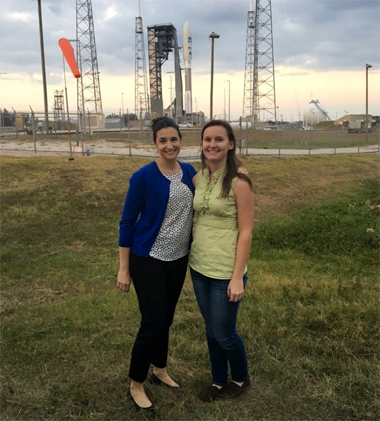Lightning Before the (Really Big) Storm
 |
|
Researchers Kristen Corbosiero (at left) and Stephanie Stevenson in Cape Canaveral, with the rocket poised to carry the GOES-16 weather satellite into space behind them. |
ALBANY, N.Y. (December 2, 2016) — Kristen Corbosiero and Stephanie Stevenson’s research got a literal boost recently in Cape Canaveral, Fla. When a Lockheed Martin satellite lifted off into geosynchronous orbit on Nov. 19, it created an exciting new source of evidence to increase their multiple studies of tropical cyclones.
Assistant Professor Corbosiero of Atmospheric and Environmental and Sciences (DAES) and Ph.D. candidate Stevenson both witnessed the launch of the Geostationary Operational Environmental Satellite (GOES), a joint project of the National Oceanic and Atmospheric Administration (NOAA) and NASA.
GOES-16, the nation’s next generation of geostationary weather satellites, will for the first time ever have the capability to continuously detect thunderstorms over the Atlantic and eastern Pacific oceans.
“This has direct impact on my current work and Stephanie’s PhD research, which is the investigation of the relationships between lightning in both the core of hurricanes and their outer rainbands and future intensity change,” said Corbosiero. “Increased lightning activity has been hypothesized to precede hurricane intensification.”
The two women have multiple research awards related to this study, which has intrigued Corbosiero since she received her master’s degree from UAlbany in 2000 and PhD in 2005. With DAES Research Professor John Molinari as co-PI, she has a $300,000 NASA grant entitled, “Investigating the influence of vertical wind shear on tropical cyclone structure and intensity change.”
The grant, which included support for an examination of the lightning and rapid intensification of Hurricane Earl, funded the first three years of Stevenson’s Ph.D. Motivated by its results, Stephenson submitted a proposal to NASA for further study on the linkage of tropical cyclone intensity change to outer rainband lightning activity that in May 2015 earned her a prestigious three-year NASA Earth and Space Science Graduate Fellowship.
Before this fellowship, Stevenson and Corbosiero partnered with the National Hurricane Center to investigate how lightning data could be used by forecasters to improve predictions of hurricane intensity. This year, they co-authored a paper that compared lightning in eastern eastern Pacific tropical cyclones to Atlantic Ocean tropical cyclones.
GOES-16, which entered geosynchronous orbit last week, directly impacts this and their other work. For the next year, sending back results from a Geostationary Lightning Mapper, it will remain over the center of the U.S. After that, NOAA will decide whether it will replace current older satellites to either the east or west.
"Detecting lightning continuously in storms in the middle of the ocean is something that has only become possible in the last decade or so," said Stevenson. "However, these early efforts have been plagued by low detection rates, so we are eager to see how our results using these ground-based networks compare to the higher detection rates that will be provided by the lightning mapper on GOES-16.”
In preparation for GOES-16, Corbosiero and Stevenson partnered with Mark DeMaria of the National Hurricane Center to receive a University Corporation for Atmospheric Research Cooperative Program for Operational Meteorology Education and Training award on “Forecasting tropical cyclone intensity change: assessing the impact of inner core lightning bursts.”
![]() For more news, subscribe to UAlbany's RSS headline feeds
For more news, subscribe to UAlbany's RSS headline feeds
A comprehensive public research university, the University at Albany-SUNY offers more than 120 undergraduate majors and minors and 125 master's, doctoral and graduate certificate programs. UAlbany is a leader among all New York State colleges and universities in such diverse fields as atmospheric and environmental sciences, business, education, public health,health sciences, criminal justice, emergency preparedness, engineering and applied sciences, informatics, public administration, social welfare and sociology, taught by an extensive roster of faculty experts. It also offers expanded academic and research opportunities for students through an affiliation with Albany Law School. With a curriculum enhanced by 600 study-abroad opportunities, UAlbany launches great careers.


